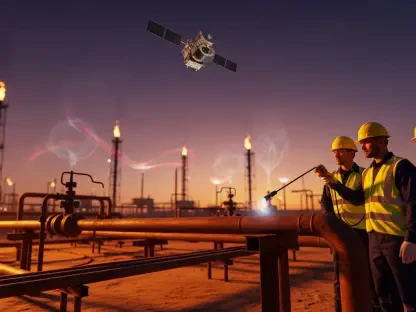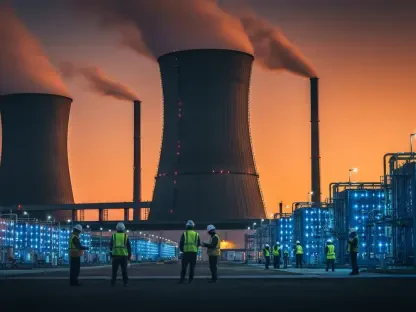In today’s rapidly evolving tech landscape, Christopher Hailstone stands out with his profound understanding of energy management and renewable resources. As companies dive deeper into artificial intelligence and digital expansion, their carbon footprints are becoming a significant concern. Christopher sheds light on how tech giants like Amazon, Microsoft, Alphabet, and Meta are grappling with rising emissions and what this means for the future of energy usage in the digital age.
What are the indirect emissions, and why are they significant when analyzing the carbon footprint of tech companies?
Indirect emissions refer to the carbon dioxide produced from the energy a company purchases and consumes to power operations, rather than emissions directly from company activities. They’re significant because they reveal the broader environmental impact of companies, especially tech firms, whose energy consumption is often indirect through massive data centers.
How do indirect emissions differ from direct emissions?
Direct emissions are those emissions directly generated from a company’s activities, like those from its own vehicles or production processes. Indirect emissions, on the other hand, arise from the consumption of purchased energy, covering activities such as cooling or heating that support the company’s operations.
What role do data centers play in the rise of indirect emissions for tech giants?
Data centers are power-hungry facilities essential for running AI and managing data, leading to substantial indirect emissions. As tech companies expand their AI capabilities, the energy demand of these centers skyrockets, thus significantly increasing indirect emissions.
How has the use of artificial intelligence by companies like Amazon, Microsoft, Alphabet, and Meta contributed to the increase in their carbon emissions?
Artificial intelligence requires immense computing power, leading to higher energy consumption. As these companies push boundaries in AI, their energy use and, consequently, their carbon emissions have surged because of the additional loads on their data centers.
Which company had the highest increase in operational carbon emissions between 2020 and 2023, and by how much did it grow?
Amazon saw the highest increase in its operational carbon emissions, with a staggering growth of 182% from 2020 to 2023, highlighting the significant environmental impact of their expanded AI and data center operations.
What measures is Amazon taking to address its rising emissions?
Amazon is investing in new carbon-free energy projects, including nuclear and renewable sources, in an effort to power its operations more sustainably and reduce its carbon footprint.
Can you explain some of the new carbon-free energy projects that Amazon is investing in?
Amazon’s investment includes projects focusing on nuclear power and renewable energy initiatives. These projects are designed to transition their energy mix towards sources that don’t emit carbon during electricity generation, thus cutting down on their indirect emissions.
How is Microsoft attempting to reduce its energy usage in data centers?
Microsoft is doubling its efforts in energy consumption savings and is on its way to transitioning to chip-level liquid cooling systems, which are designed to be more efficient than traditional systems.
What is chip-level liquid cooling, and how does it differ from traditional cooling systems?
Chip-level liquid cooling involves directly cooling the microchips with liquid, which is more efficient because it removes heat more effectively at the source. Traditional cooling systems usually rely on air to cool the entire room, which is less efficient.
Why might chip-level liquid cooling be more energy-efficient?
It enhances energy efficiency by reducing the amount of cooling required overall. Since this method targets the chips directly, it decreases the energy load usually spent in the broader ambient cooling used in traditional systems.
What challenges or barriers are digital companies facing in translating emissions targets into actual reductions?
Companies are encountering difficulties due to the scale of energy demands and the rapid expansion of technologies like AI, which often outpace the improvements made in energy efficiency and renewables.
The report states that electricity use by data centers is increasing four times faster than the overall rise in electricity consumption. What factors are driving this rapid increase?
The exponential growth in AI applications and digital services is a major factor, as these data centers need more electricity to handle increasing data volumes and computational demands.
How might the growth of artificial intelligence strain existing energy infrastructure?
The rising energy demands from AI growth can pressure the current infrastructure, possibly leading to overcapacity issues and necessitating infrastructure upgrades to manage the increased load effectively.
What is the predicted carbon emission output for top-emitting AI systems, according to the report?
The report predicts that these systems could emit up to 102.6 million tons of carbon dioxide equivalent per year, illustrating the massive environmental footprint they could represent.
How are tech companies addressing the potential pressure on energy infrastructure caused by expanding AI development?
Many are investing in energy-efficient technologies, exploring renewable energy sources, and making architectural changes in data centers to mitigate the substantial pressure their operations exert on current energy frameworks.
What are some of the sustainability initiatives and goals mentioned in Meta’s sustainability report?
Meta is focusing on reducing emissions and minimizing energy and water usage in their data centers as part of their commitment to sustainability.
How are global emissions targets impacting the strategies of large technology companies like those mentioned?
These targets push companies to innovate and invest further in cleaner technologies and sustainable practices, aiming not just to meet regulatory requirements but also to maintain competitive edge.
What role does the International Telecommunication Union (ITU) play in monitoring and assessing emissions from digital companies?
The ITU assesses the environmental impact of digital businesses and sets standards, offering valuable data and insights that help companies track and manage their emissions effectively.
How might advancements in AI technology further affect the emissions landscape in the tech industry?
AI advancements could both increase emissions, due to greater energy demands, and decrease them, by making processes more efficient. The key will be balancing technological progress with sustainable practices.
What actions could tech companies take to achieve meaningful reductions in their carbon footprints moving forward?
Companies should focus on integrating more renewable energy sources, improving energy efficiency technologies, and setting actionable goals that align with global climate efforts.









